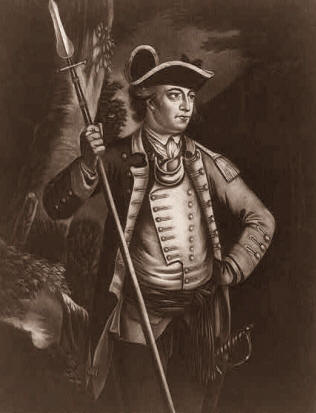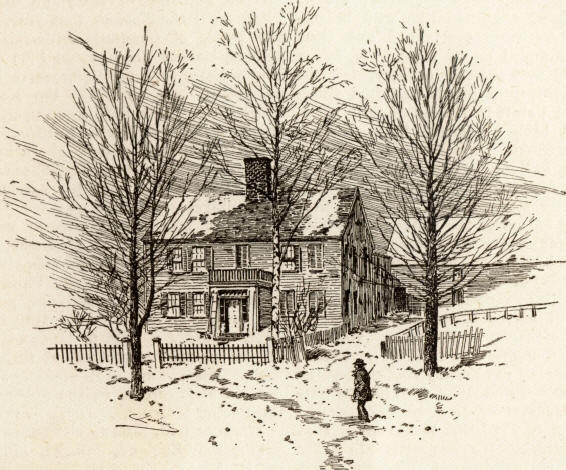|
This Site:
Discovery of America
The Explorers
Post Columbian Exploration
Thirteen Original Colonies
Colonization of America
Colonial Life
Colonial Days and Ways
Independence Movement
The Patriots
Prelude to War
Revolutionary War
Revolutionary War Battles
Overview of Revolutionary War
Revolutionary War
Timeline
Civil War
American Flag
Mexican War
Republic of Texas
Indians
|
 Sullivan,
JOHN, military officer; born in Berwick, Me., February
17, 1740; was a lawyer, an earnest patriot, and a member of the
first Continental
Congress. In December, 1774, he, with
John Langdon, led a force
against Fort William and Mary, near Portsmouth, and took from it 100
barrels of gunpowder, fifteen cannon, small-arms, and stores. In
June, 1775, he was appointed one of the brigadier - generals of the
Continental army, and
commanded on Winter Hill in the siege of Boston. After the
evacuation in March, 1776, he was sent with troops to reinforce the
army in Canada, of which he took command on the death of General
Thomas, June 2, 1776, and soon afterwards exhibited great skill in
effecting a retreat from that province. On the arrival of
Gates to succeed
Sullivan, the latter joined the army under
George Washington at
New York, and at the
battle of Long Island, in
August, he was made prisoner. He was soon exchanged for General
Prescott, and, joining Washington in Westchester county, accompanied
him in his retreat across New
Jersey. On the capture of Lee, he took command of the troops
under that officer, and performed good service at
Trenton and
Princeton. In August, 1777, he made an unsuccessful attack on the
British on Staten Island, and then joining Washington, commanded the
right wing in the battle of Brandywine. He skillfully led in the
battle of Germantown, and would have driven the British from
Rhode Island, or captured
them, in August, 1778, had not D'Estaing failed to cooperate with
him. After a sharp battle, he withdrew with slight loss. The
atrocities of the Indians (especially the Senecas, the most westerly
of the Six Nations)
in the Wyoming Valley, and their continual raids upon the frontier
settlements in New York, caused a retaliatory expedition to be made
into their country in the summer of 1779. It was led by General
Sullivan, who was instructed to "chastise and humble the Six
Nations." He collected troops in the Wyoming Valley, and marched
(July 31), up the Susquehanna with about 3,000 soldiers. At Tioga
Point he met (August 22) General James Clinton, who had come from
the Mohawk Valley with about 1,600 men to join him. On the 29th they
fell upon some Tories and Indians who were pretty strongly fortified
at Chemung (now Elmira), and dispersed them. Before they could
rally, Sullivan had pushed onward to the Genesee River, when he
began the work of destruction. In the course of three weeks he
destroyed forty Indian villages and a vast amount of food growing in
fields and gardens. In fields and granaries 160,000 bushels of corn
were wasted by fire. The Senecas had planted orchards in the rich
openings in the forest. These were destroyed. A vast number of the
finest apple and pear trees, the product of many years of growth,
fell before the axe; hundreds of gardens abounding with edible
vegetables were desolated; the inhabitants were hunted like wild
beasts; their altars were overturned and their graves trampled on by
strangers; and a beautiful, well-watered country, teeming with a
prosperous people and just rising from a wild state by the aid of
cultivation, was cast back a century in the course of a few weeks.
This dreadful scourging awed the Indians for the moment, but it did
not crush them. In the reaction they had greater strength, and by it
the fires of deeper hatred of the white people were kindled far and
wide among the tribes upon the borders of the Great Lakes and in the
valley of the Ohio. After this campaign Sullivan resigned his
commission on account of his shattered health, and received the
thanks of Congress. He took a seat in Congress late in 1780, and
aided in suppressing the mutiny in the Pennsylvania line. From 1782
to 1786 he was attorney-general of
New Hampshire, and from
1786 to 1789 was president of that commonwealth. He was active in
other public employments, and saved the State from great confusion
by his prudence and intrepidity when discontented persons were
stirring up the spirit of insurrection. From 1789 until his death he
was United States judge of New Hampshire. He died in Durham, N. H.,
January 23, 1795. Sullivan,
JOHN, military officer; born in Berwick, Me., February
17, 1740; was a lawyer, an earnest patriot, and a member of the
first Continental
Congress. In December, 1774, he, with
John Langdon, led a force
against Fort William and Mary, near Portsmouth, and took from it 100
barrels of gunpowder, fifteen cannon, small-arms, and stores. In
June, 1775, he was appointed one of the brigadier - generals of the
Continental army, and
commanded on Winter Hill in the siege of Boston. After the
evacuation in March, 1776, he was sent with troops to reinforce the
army in Canada, of which he took command on the death of General
Thomas, June 2, 1776, and soon afterwards exhibited great skill in
effecting a retreat from that province. On the arrival of
Gates to succeed
Sullivan, the latter joined the army under
George Washington at
New York, and at the
battle of Long Island, in
August, he was made prisoner. He was soon exchanged for General
Prescott, and, joining Washington in Westchester county, accompanied
him in his retreat across New
Jersey. On the capture of Lee, he took command of the troops
under that officer, and performed good service at
Trenton and
Princeton. In August, 1777, he made an unsuccessful attack on the
British on Staten Island, and then joining Washington, commanded the
right wing in the battle of Brandywine. He skillfully led in the
battle of Germantown, and would have driven the British from
Rhode Island, or captured
them, in August, 1778, had not D'Estaing failed to cooperate with
him. After a sharp battle, he withdrew with slight loss. The
atrocities of the Indians (especially the Senecas, the most westerly
of the Six Nations)
in the Wyoming Valley, and their continual raids upon the frontier
settlements in New York, caused a retaliatory expedition to be made
into their country in the summer of 1779. It was led by General
Sullivan, who was instructed to "chastise and humble the Six
Nations." He collected troops in the Wyoming Valley, and marched
(July 31), up the Susquehanna with about 3,000 soldiers. At Tioga
Point he met (August 22) General James Clinton, who had come from
the Mohawk Valley with about 1,600 men to join him. On the 29th they
fell upon some Tories and Indians who were pretty strongly fortified
at Chemung (now Elmira), and dispersed them. Before they could
rally, Sullivan had pushed onward to the Genesee River, when he
began the work of destruction. In the course of three weeks he
destroyed forty Indian villages and a vast amount of food growing in
fields and gardens. In fields and granaries 160,000 bushels of corn
were wasted by fire. The Senecas had planted orchards in the rich
openings in the forest. These were destroyed. A vast number of the
finest apple and pear trees, the product of many years of growth,
fell before the axe; hundreds of gardens abounding with edible
vegetables were desolated; the inhabitants were hunted like wild
beasts; their altars were overturned and their graves trampled on by
strangers; and a beautiful, well-watered country, teeming with a
prosperous people and just rising from a wild state by the aid of
cultivation, was cast back a century in the course of a few weeks.
This dreadful scourging awed the Indians for the moment, but it did
not crush them. In the reaction they had greater strength, and by it
the fires of deeper hatred of the white people were kindled far and
wide among the tribes upon the borders of the Great Lakes and in the
valley of the Ohio. After this campaign Sullivan resigned his
commission on account of his shattered health, and received the
thanks of Congress. He took a seat in Congress late in 1780, and
aided in suppressing the mutiny in the Pennsylvania line. From 1782
to 1786 he was attorney-general of
New Hampshire, and from
1786 to 1789 was president of that commonwealth. He was active in
other public employments, and saved the State from great confusion
by his prudence and intrepidity when discontented persons were
stirring up the spirit of insurrection. From 1789 until his death he
was United States judge of New Hampshire. He died in Durham, N. H.,
January 23, 1795.

The Home of General John Sullivan
|
 Sullivan,
JOHN, military officer; born in Berwick, Me., February
17, 1740; was a lawyer, an earnest patriot, and a member of the
first
Sullivan,
JOHN, military officer; born in Berwick, Me., February
17, 1740; was a lawyer, an earnest patriot, and a member of the
first 